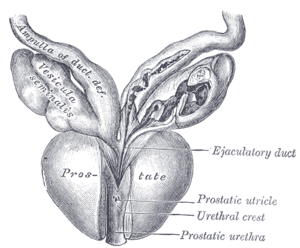Seminal vesicle
| Seminal vesicle | |
|---|---|
 | |
| Human Male Anatomy | |
 | |
| Prostate with seminal vesicles and seminal ducts, viewed from in front and above. | |
| Latin | Vesiculae seminales |
| Gray's | subject #260 1246 |
| Artery | Inferior vesical artery, middle rectal artery |
| Lymph | External iliac lymph nodes, internal iliac lymph nodes |
| Precursor | Wolffian duct |
| MeSH | Seminal+Vesicles |
The seminal vesicles (glandulae vesiculosae) or vesicular glands [1] are a pair of simple tubular glands posteroinferior to the urinary bladder of male mammals. They are located within the pelvis.
Anatomy
Each seminal vesicle spans approximately 5 cm, though its full unfolded length is approximately 10 cm, but it is curled up inside the gland's structure. Each vesicle forms as an outpocketing of the wall of the ampulla of one vas deferens.
The excretory duct of each seminal gland opens into the vas deferens as it enters the prostate gland.
Function
The seminal vesicles secrete a significant proportion of the fluid that ultimately becomes semen. Lipofuscin granules from dead epithelial cells give the secretion its yellowish color. About 50-70%[2] of the seminal fluid in humans originates from the seminal vesicles, but is not expelled in the first ejaculate fractions which are dominated by spermatozoa and zinc-rich prostatic fluid. The excretory duct of each seminal gland opens into the corresponding vas deferens as it enters the prostate gland. Seminal vesicle fluid is alkaline, resulting in human semen having a mildly alkaline pH.[3] The alkalinity of semen helps neutralize the acidity of the vaginal tract[citation needed], prolonging the lifespan of sperm. Acidic ejaculate (pH <7.2) may be associated with Ejaculatory duct obstruction. The vesicle produces a substance that causes the semen to become sticky/jelly-like after ejaculation.
The thick secretions from the seminal vesicles contain proteins, enzymes, fructose, mucus, vitamin C, flavins, phosphorylcholine and prostaglandins. The high fructose concentrations provide nutrient energy for the spermatozoa when stored in semen in the laboratory.
In vitro studies have shown that sperm expelled together with seminal vesicular fluid show poor motility and survival, and the sperm chromatin is less protected. Therefore the exact physiological importance of seminal vesicular fluid is not clear.
Histology


Histologically, the seminal vesicles are notable for their tortuous pathways, diverticula, pseudo-stratified columnar epithelium and cuboidal cells along the basal layer.

The height of these columnar cells, and therefore activity, is dependent upon testosterone levels in the blood.[citation needed]
The lumen is large and stores the fluid secretions (but not spermatozoa) between ejaculations.
From inside to out, the layers are:
- Mucosa - arranged into convoluted folds, significantly increasing surface area
- Muscular - well-developed layer composed of an inner circular and outer longitudinal layer of smooth muscle
- Connective tissue[citation needed]
Additional images
-

Human male reproductive system.
-

Seminal vesicles
-

Coronal section of pelvis, showing arrangement of fasciae. Viewed from behind.
-

Male pelvic organs seen from right side.
-

Fundus of the bladder with the vesiculae seminales.
-

Vesiculae seminales and ampullae of ductus deferentes, seen from the front.
-

Vertical section of bladder, penis, and urethra.
-
Cross section of seminal vesicle through a microscope.
References
- ↑ Wilke; W. Lee Wilke, Rowen D. Frandson, Anna Dee Fails (2009). Anatomy and Physiology of Farm Animals. John Wiley and Sons. ISBN 0-8138-1394-8. Retrieved 2013-11-03.
- ↑ Kierszenbaum, Abraham L. (2002). Histology and cell biology : an introduction to pathology. St. Louis [u.a.]: Mosby. p. 558. ISBN 0-323-01639-1.
- ↑ "CHEMICAL COMPOSITION OF HUMAN SEMEN AND OF THE SECRETIONS OF THE PROSTATE AND SEMINAL VESICLES". http://ajplegacy.physiology.org. Retrieved 2010-08-10.
External links
- BU Histology Learning System: 17501loa - "Male Reproductive System: prostate, seminal vesicle"
- 44:04-0202 at the SUNY Downstate Medical Center - "The Male Pelvis: The Urinary Bladder"
- 44:08-0103 at the SUNY Downstate Medical Center - "The Male Pelvis: Structures Located Posterior to the Urinary Bladder"
| |||||||||||||||||||||||
| ||||||||||||||||||||||||||||||||||
| |||||||||||||||||||||||||||||||||||||||||||||||||||||||||||||
